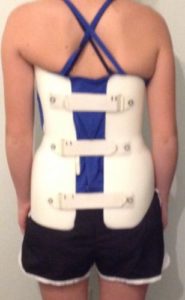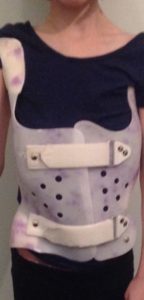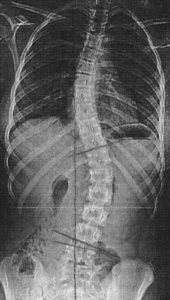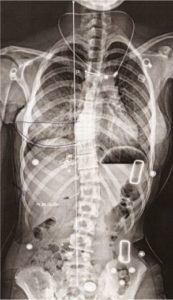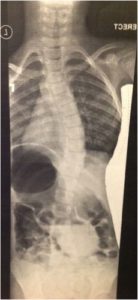Comparison of the Boston and the Rigo-Cheneau Rigid Scoliosis Braces
My colleagues (Susan Henning PT, PRC, Advanced Schroth Certified, Jean Masse PT, PRC Advanced Schroth Certified) and I (Lisa Mangino PT, PRC, Advanced Schroth Certified) at Advance Physical Therapy are seeing the positive effects that a good scoliosis brace can have on the growing spine of patients with Adolescent Idiopathic Scoliosis (AIS).
The wonderful thing about a rigid brace, for both night time and/or day time use, is that it is somewhat like having hands holding the patient’s spine in a corrected position (and out of their curve pattern) without the person having to consciously think about it. A good rigid brace uses padding and plastic to apply centralizing and de-rotating forces to the prominent places to correct the spinal alignment to the straightest position possible.
One sign of a less effective brace is that it may also contact the person’s rib cage in the places that aren’t prominent, or where we actually want to the child’s rib cage to expand. This is one of the short-comings of the Boston Brace. This brace begins as a cylinder and a skilled orthotist adds padding to the area that needs corrective forces. However, the cylinder is not expanded in the places where the child’s rib cage needs to expand.
Above is an example of a Boston Brace. Notice the overall cylindrical shape, especially in the photo on the left. It opens and closes in the back, making it more difficult for the adolescent to have independence in putting it on and taking it off. The area under her left shoulder blade is an area we would like her to expand her rib cage to allow for improved air flow, however the Boston Brace contacts her rib cage here making active muscle use for expansion impossible.
Contrarily, the Rigo-Cheneau Brace is a custom made brace that applies pressure to the areas that we want to centralize and de-rotate, while expanding and not contacting the patient’s rib cage in the opposite areas to allow for active muscle use and expansion with breath. This means that as the patient is wearing this brace they are benefiting from the corrective forces, and are also able to activate muscles to open spaces to allow for more even airflow within the rib cage, acting to normalize spinal and rib cage position frequently throughout the day.
Above is an example of the Rigo Cheneau Brace. Notice the overall non-cylindrical and more custom shape of the brace. It opens and closes in the front for ease of use and independence by the wearer. Again, the area we want this patient to expand is under the left shoulder blade. There is no padding here and the brace is not in contact with the person’s body. We actively work on helping her activate the muscles between her ribs and in her upper back to actively expand this area to allow for more balanced air-flow and expansion.
So what is going on inside? So far I’ve had 2 patients who first received a Boston Brace. After some conversation about the benefits of the Rigo-Cheneau Brace, both families decided to switch to the Rigo-Cheneau. Here are their x-ray comparisons: no brace, Boston Brace, and Rigo-Cheneau Brace:
The patient above is 13 years old and her x-rays were taken in July, September, and November 2015, respectively.
The patient above was 7 years old at time of the first photo in February of 2015. The second x-ray in her Boston Brace was taken in March, and the third x-ray in her Rigo-Cheneau brace was taken in April 2015.
The results in these 2 cases are clear. If you would like more information about the Rigo-Cheneau brace, please do not hesitate to contact our office and we can put you in touch with the orthotist who can help you. Further, we offer asymmetric scoliosis specific exercises, as anyone who requires a rigid brace for scoliosis, also should be engaging in PT to strengthen the muscles to hold the corrected position. (Negrini et al. 2011 SOSORT Guidelines: Orthopaedic and Rehabiliation treatment of idiopathic scoliosis during growth. Scoliosis. 2012, 7:3, p. 1-35.)
For further reading:
- Rivette, LA, Stewart, A, Potterton, J. The effect of compliance to a Rigo System Cheneau brace and a specific exercise programme on idiopathic scoliosis curvature: a comparative study: SOSORT 2014 award winner. Scoliosis, 9:5, May 2014. http://www.scoliosisjournal.com/content/9/1/5
- Rigo, M. “3D Correction of Trunk Deformity in Patients with Idiopathic Scoliosis Using Cheneau.” Research into spinal deformities 22 (1999): 362.
- Rigo, Manuel D., Mónica Villagrasa, and Dino Gallo. “A specific scoliosis classification correlating with brace treatment: description and reliability.”Scoliosis1 (2010): 1-11.
- Lehnert-Schroth, C., The Three Dimensional Treatment for Scoliosis, A Physiotherapeutic Method For Deformities of the Spine, The Martindale Press, 2007.
- Plaszewski, M (2014): Non-surgical interventions for adolescents with idiopathic scoliosis: An overview of systematic reviews.
Lisa Mangino, PT, DPT, PCS, C/NDT, PRC
Pediatric Physical Therapy
Email: lisa@advance-physicaltherapy.com

